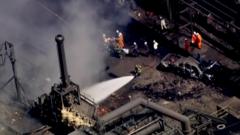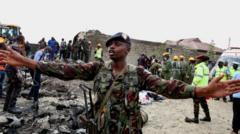In the wake of the Air India Flight AI171 disaster, which resulted in significant casualties shortly after take-off, experts investigate various potential causes, including engine failure, bird strikes, and pilot error. As the investigation unfolds, several theories emerge regarding the crash's rapid descent.
Investigating the Tragic Crash of Air India Flight AI171: Insights and Theories

Investigating the Tragic Crash of Air India Flight AI171: Insights and Theories
A detailed exploration of the factors and possible causes behind the sudden crash of Air India Flight AI171 shortly after take-off, claiming 241 lives.
In a shocking aviation tragedy, Air India Flight AI171, a Boeing 787-8 Dreamliner, crashed just 30 seconds after taking off from Sardar Vallabhbhai Patel International Airport in Ahmedabad en route to London Gatwick, claiming the lives of all 241 individuals onboard and several on the ground. Initial reports from the scene indicate the crash occurred approximately 1.5 kilometers (0.9 miles) from the runway, raising numerous questions about the factors that led to such a catastrophic event.
An investigation is underway, involving Indian authorities alongside teams from the U.S. and UK, tasked with uncovering the mysteries surrounding the crash. The aircraft, operated by an experienced crew totaling over 9,000 flying hours, took off at 1:39 PM local time with a full fuel load of 100 tons. Shortly after gaining altitude, the cockpit issued a mayday call, indicating distress, but no further communication was received as eyewitness reports described the aircraft struggling for altitude before its sudden descent.
Experts have posited several theories that could explain the unfortunate accident. Among them is the highly improbable occurrence of a double engine failure, with concerns raised about the aircraft's Ram Air Turbine (RAT), an emergency device that activates under certain power loss conditions. Previous incidents highlight the rarity of such failures, and while some pilots speculated this could have been a contributing factor, others are cautious about jumping to conclusions based solely on the scant available footage.
The possibility of a bird strike has also been brought to light, with Ahmedabad's airport notorious for numerous bird-related incidents, which could potentially jeopardize engine performance. Given the high number of reported bird strikes in the region, this remains a serious concern amongst flight safety experts.
Another theory centers on the aircraft's configurations during take-off, particularly the flaps. Their proper extension is imperative for optimal thrust in hot and thin air conditions, similar to those experienced during the flight. Any error in this crucial setting could lead to a severe loss of lift.
The subsequent investigation promises to be complicated, analyzing black box data and the crash site itself for clues. Boeing and GE Aerospace have pledged resources to assist with the inquiry. Until a concrete conclusion can be drawn, the focus remains on determining what went awry in those harrowing moments after take-off, as the world mourns the loss of those aboard AI171.



















